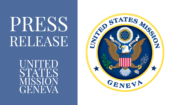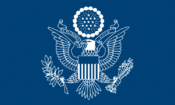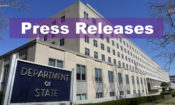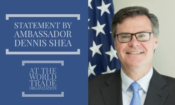
Remarks as delivered by Ambassador Pamela Hamamoto
CERN,
Geneva, Friday, December 18, 2015
Good morning, everybody. This is truly a good day for the relationship between CERN and the United States. Today, I’m proud to join Director General Heuer in signing important cooperation documents that promise to yield new insights into fundamental particles, laws of nature and our universe — five documents that are the latest chapter in a long history of collaboration that goes back to the very creation of this institution.
So much has changed in our world during the last 60 years, since CERN was founded, much of it thanks to CERN and to experiments such as those at the Large Hadron Collider. I read somewhere that to make those beams of particles collide with one another is like trying to shoot two needles, one from North America and another from Europe, and make them collide in mid-air over the North Atlantic. And I thought that multilateral diplomacy was hard! What you all are doing here – exploring the mysteries of the universe – is to us lay people a whole new world of complexity!
Which is why so much of what happens here has captured the imagination of the public at large. Although many of us do not fully understand the role and properties of leptons, quarks and other gluons, we do understand the “universal” benefits that stem from your work at CERN, such as the birth of the World Wide Web. And we are excited by what has started to emerge from breakthrough discoveries like the Higgs boson…which I hear may have a new cousin!
To work here, you have to be an explorer. You have to ask questions, big questions about our knowledge of the cosmos and our place in it. Often this curiosity starts very early. When American physicist Isidor Rabi grew up in Brooklyn, most of his friends’ parents in this immigrant neighborhood would ask their children after school, “Did you learn anything today?” But not Isidor’s mother. “Izzy,” she would say, “did you ask a good question today?” And that’s what helped shape him as a scientist, long before he became one of CERN’s founders.
This sense of exploration underlies the protocols before us today – protocols to push crucial scientific and diplomatic frontiers and to expand our collaboration and understanding of the universe by working together, across borders and cultures. Because the laws and mysteries of physics know no borders. But also because collaboration, as Director General Heuer once put it, “is to appreciate the differences, and to use these differences to progress.”
Professor Heuer, I know how much this matters to you…the importance of international cooperation, as embodied in your vision for a network of international labs. I understand this is one of your very last public events as Director General and I want to take this opportunity to thank you, on behalf of the United States, for what you have accomplished at the helm of CERN. You have been a friend and a progressive force at a defining moment of this institution’s history. And we look forward to continuing this productive relationship with your successor, Dr. Fabiola Gianotti.
Particle physics looks into the very small and fundamental. There is nothing more fundamental than what unites us here today — the desire and commitment to combine our strengths and expertise to solve the defining challenges and questions of our time.
CERN is a shining example of international cooperation…of what we can do in Geneva and beyond when we stand together and reach for a common goal.
Thank you, Professor Heuer, for your leadership.
Thank you to all those at CERN, for your partnership.
And our deepest thanks to all of you, for keeping this valuable relationship alive, vibrant and successful.
(end remarks)















